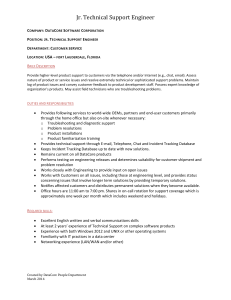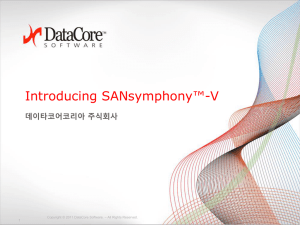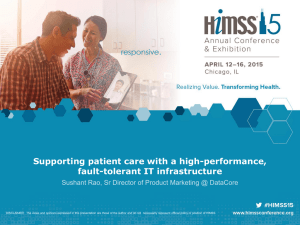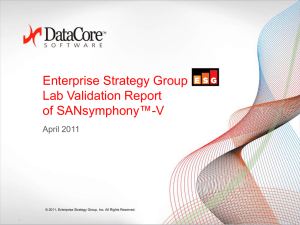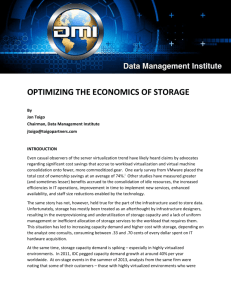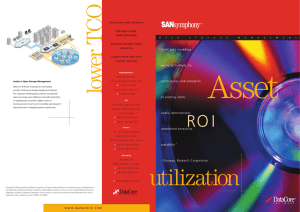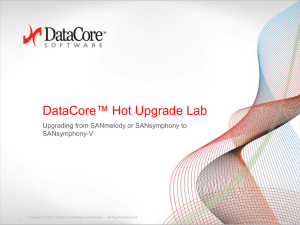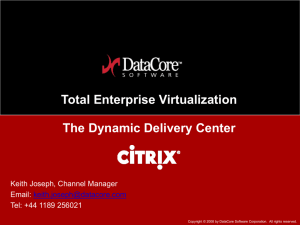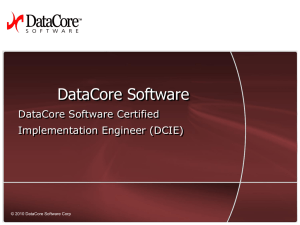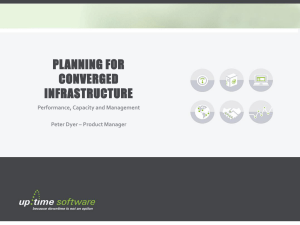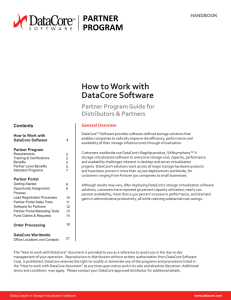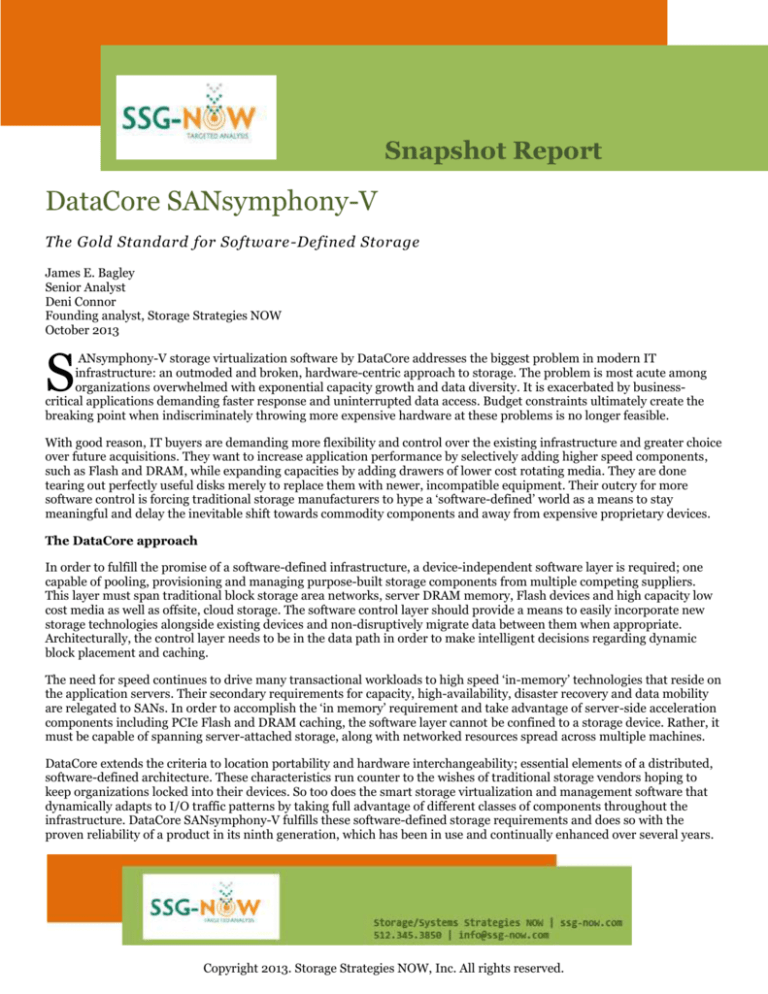
Snapshot Report
DataCore SANsymphony-V
The Gold Standard for Software -Defined Storage
James E. Bagley
Senior Analyst
Deni Connor
Founding analyst, Storage Strategies NOW
October 2013
S
ANsymphony-V storage virtualization software by DataCore addresses the biggest problem in modern IT
infrastructure: an outmoded and broken, hardware-centric approach to storage. The problem is most acute among
organizations overwhelmed with exponential capacity growth and data diversity. It is exacerbated by businesscritical applications demanding faster response and uninterrupted data access. Budget constraints ultimately create the
breaking point when indiscriminately throwing more expensive hardware at these problems is no longer feasible.
With good reason, IT buyers are demanding more flexibility and control over the existing infrastructure and greater choice
over future acquisitions. They want to increase application performance by selectively adding higher speed components,
such as Flash and DRAM, while expanding capacities by adding drawers of lower cost rotating media. They are done
tearing out perfectly useful disks merely to replace them with newer, incompatible equipment. Their outcry for more
software control is forcing traditional storage manufacturers to hype a ‘software-defined’ world as a means to stay
meaningful and delay the inevitable shift towards commodity components and away from expensive proprietary devices.
The DataCore approach
In order to fulfill the promise of a software-defined infrastructure, a device-independent software layer is required; one
capable of pooling, provisioning and managing purpose-built storage components from multiple competing suppliers.
This layer must span traditional block storage area networks, server DRAM memory, Flash devices and high capacity low
cost media as well as offsite, cloud storage. The software control layer should provide a means to easily incorporate new
storage technologies alongside existing devices and non-disruptively migrate data between them when appropriate.
Architecturally, the control layer needs to be in the data path in order to make intelligent decisions regarding dynamic
block placement and caching.
The need for speed continues to drive many transactional workloads to high speed ‘in-memory’ technologies that reside on
the application servers. Their secondary requirements for capacity, high-availability, disaster recovery and data mobility
are relegated to SANs. In order to accomplish the ‘in memory’ requirement and take advantage of server-side acceleration
components including PCIe Flash and DRAM caching, the software layer cannot be confined to a storage device. Rather, it
must be capable of spanning server-attached storage, along with networked resources spread across multiple machines.
DataCore extends the criteria to location portability and hardware interchangeability; essential elements of a distributed,
software-defined architecture. These characteristics run counter to the wishes of traditional storage vendors hoping to
keep organizations locked into their devices. So too does the smart storage virtualization and management software that
dynamically adapts to I/O traffic patterns by taking full advantage of different classes of components throughout the
infrastructure. DataCore SANsymphony-V fulfills these software-defined storage requirements and does so with the
proven reliability of a product in its ninth generation, which has been in use and continually enhanced over several years.
Copyright 2013. Storage Strategies NOW, Inc. All rights reserved.
What sets DataCore apart from others?
Unlike established storage manufacturers, DataCore is an independent software vendor, free from the biases that plague
hardware manufacturers. The company is fully dedicated to getting the best value from the available resources, at once
extending their useful life while facilitating the injection of future technologies from potentially new suppliers. Not only
does the SANsymphony-V software support all the popular storage devices, it is also OS- and hypervisor-agnostic; equally
at ease running on the host, in the SAN or across both. You can see this in the diagram below.
The SANsymphony-V software is also an active participant in storage processes, not just a service broker from the
sidelines. It actively improves availability, performance and quality of service, balancing the mix of capacity storage with
premium priced Flash, while supplementing both with high-speed DRAM caching and metro-wide synchronous
mirroring, remote replication and many other advanced storage services. Unlike the so-called software-defined storage
offerings from the largest storage manufacturers, DataCore is in the data path making workload placement and access
decisions dynamically. Other approaches simply translate between application program interfaces (APIs), unable to make
up for the shortcomings of the underlying storage systems.
DataCore Software-Defined Storage Architecture
Comprehensive, infrastructure-wide functionality
DataCore provides a single unified software-defined storage platform with a complete set of advanced functions usually
found only on the priciest of enterprise disk arrays. In contrast, DataCore implements these functions outside the box, as
an infrastructure-wide layer where they can control and benefit not just one enclosure, but all of the storage assets
available to the organization.
Along with, caching, mirroring, auto-tiering, and pooling (a.k.a. federated storage) across devices, SANsymphony-V
implements thin provisioning, continuous data protection (CDP), online snapshots, load balancing, asynchronous remote
replication and other features, without the expense and headache of implementing multiple versions of these services on
each unit. The DataCore solution also provides unified functions for both block device access (SAN) and file access (NAS),
non-disruptive virtual disk migration and access to cloud gateways. Together, these functions provide intelligent and
adaptive software for the best user experience.
In-memory I/O caching boosts native storage performance
DataCore uses ‘in-memory’ caching to speed up I/O response, placing the most frequently accessed data as close to the
application as possible. It will even tap the application server’s main memory (DRAM) for very latency-sensitive
environments. The caching algorithms running on very fast multi-core CPUs boost read and write performance enabling
the vast majority of storage accesses to be delivered to your applications at speeds that are hundreds of times faster than
waiting on back-end disks. It avoids the need to over provision disk drives, or spend too much on solid state technologies
(flash and SSDs).
Optimal combination of Commodity DRAM, Flash and Spinning Disk Technologies
The combination of DRAM caching with cross-device auto-tiering effectively ‘super charges’ existing storage investments
with minimal, if any, additional hardware. It’s a clever method to arrive at the optimal blend of Flash, high capacity drives,
bulk disks and cloud storage.
Costs reductions come from less equipment necessary to achieve better business response and less effort spent managing
it. Complementing the performance, management and utilization benefits are the enhanced system availability realized by
minimizing storage-related downtime and maintaining revenue production capacity.
Our Take
With the term ‘software-defined storage’ (SDS) being blurred by the hype of so many hardware vendors who say ‘I have it,’
DataCore provides a refreshingly complete solution to the broken storage model. Data center operators that desire the
flexibility of a true SDS platform will be well served by implementing DataCore’s SANsymphony-V before looking at their
next storage hardware acquisition.
SANsymphony-V software-defined storage functions layered
across diverse storage resources
About SSG-NOW™
SSG-NOW is an industry analyst firm focused on storage, server, cloud, virtualization and networking technologies. Our
goal is to convey the business value of adopting these technologies to corporate stakeholders in a concise and easy-tounderstand manner.
Note: The information and recommendations made by SSG-NOW are based upon public information and sources and may also include personal opinions both of SSG-NOW and
others, all of which we believe to be accurate and reliable. As market conditions change however, and not within our control, the information and recommendations are made
without warranty of any kind. All product names used and mentioned herein are the trademarks of their respective owners, SSG-NOW. assumes no responsibility or liability for any
damages whatsoever (including incidental, consequential or otherwise), caused by your use of, or reliance upon, the information and recommendations presented herein, nor for
any inadvertent errors which may appear in this document.
Copyright 2013. SSG-NOW. All rights reserved.

